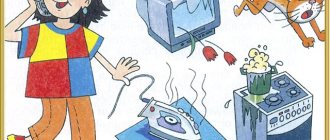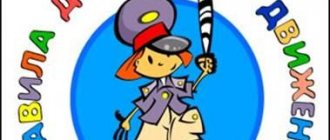Summary of OOD in the senior group on the topic “Safety in the forest and park”
Summary of OOD in the senior group on the topic “Safety in the forest and park”
Author: Chirova Polina Sergeevna, teacher of MBDOU No. 79 “BOY-KIBALCHISH”, Severodvinsk
This work is useful for educators. The summary is intended for children of the older group (5-6 years old). The notes can be used as a main lesson, as well as as a circle lesson.
Program content:
Target:
Formation of children's knowledge about the rules of safe behavior in nature (in the forest, park).
Tasks:
1. Formation of knowledge in children about sources of danger in the forest, park: insects, plants, fire, old trees.
2. Formation of knowledge in children about the rules of safe behavior in the forest.
3. Formation of knowledge in children about actions in dangerous situations in the forest.
4. Development of attention and logical thinking.
5. Foster a sense of caring for your health.
Methods and techniques:
conversation, looking at illustrations, reading poems, artistic expression, didactic games, reading fiction.
Progress of the lesson:
Educator:
Guys, today we will go for a walk in the forest. What is a forest? (many trees, mushrooms and berries grow, animals live in the forest).
- Why do people go to the forest? (rest, breathe fresh air, pick mushrooms, berries). What is a park? Why do we go to the park?
- Right! Why do we need fresh air? (so as not to get sick, to be healthy).
— A forest is the green wealth of nature, beauty, health, a place where you can relax and take a walk! So now we will go with you to the forest to relax and breathe fresh air. And for a walk in the forest, we need to take with us items that may be useful to us.
A d/i “What should we take with us on a hike” is held - items that may be useful in the forest are selected.
Educator:
It seems they took everything and forgot nothing.
(audio recording “Sounds of Nature” is played)
Educator:
So we came to the forest. Let's look at the illustrations on the board. What do they show? What dangers await us in the forest and in the park?
Do you know what grows in the forest? (mushrooms, berries, herbs).
- Now we’ll check how you know the plants of the forest. (Game “Edible-Inedible”.
Educator:
How many mushrooms and berries grow in the forest! Are we collecting them? (Yes)
— Can all mushrooms, berries, and herbs be picked? (no, there are edible and inedible, poisonous).
— Why can’t you collect inedible plants?
They cannot be collected, as they are hazardous to health and also serve as medicine for animals.
Listen to one short story. The girl Masha was picking berries when she suddenly saw an unusual, unfamiliar berry, ate it, and after a while her stomach hurt. What should a girl do? (children's answers).
MAGAZINE Preschooler.RF
Pedagogical project on the topic: “Children’s safety in nature”MUNICIPAL AUTONOMOUS PRE-SCHOOL EDUCATIONAL INSTITUTION KINDERGARTEN No. 58 “PEARL” SHCHELKOVSKY MUNICIPAL DISTRICT OF THE MOSCOW REGION
Educator: Ivanyukhina R.P. Shchelkovo
One of the tasks in the work of a preschool institution is to protect the life and health of children. Adults must protect and protect the child, prepare him to face various difficult and sometimes dangerous life situations. A child is interested in absolutely everything: he wants to touch, taste, feel, see, hear. A child’s natural curiosity in understanding the world around him can become unsafe for him. A child, not knowing the rules of safe behavior, can harm not only the environment, but also himself (for example, picking poisonous plants, trying unfamiliar berries, picking up mushrooms, touching insects and animals, etc.).
Therefore, the issues of instilling in children the skills of safe behavior, the ability to anticipate dangerous situations and, if possible, avoid them are very relevant. As a result of conversations with children, games, and observations during walks, it was revealed that children are practically unfamiliar with the basic rules of behavior in nature. It was also revealed that parents are not sufficiently aware of the need to specially familiarize their children with these rules. Based on all this, I chose the theme of the project “Children’s Safety in Nature ,” which is based on developing children’s skills for safe behavior in nature.
There is a formula for safety: You must see, anticipate, take into account. If possible, avoid everything, and where necessary, call for help.
Project type: educational and informational.
By number of participants: group.
Project duration: long-term.
Project participants: teachers, middle school children, parents.
Project implementation period: spring-summer 2015.
The goal of the project: to summarize children’s ideas about the basic rules of safe behavior in nature.
Tasks:
- Teach children basic rules of behavior in nature.
- To form in preschoolers an idea of the dangers that arise from contact with animals and insects.
- Develop an educational interest in the natural world, combining it with familiarization with dangerous plants, berries, and mushrooms.
- Develop personal safety skills.
- Foster a desire to preserve and protect nature.
Planned results:
- Children will develop an understanding of what can be dangerous when communicating with nature.
- Children will master the skills of safe behavior in various dangerous situations.
- Children will develop an interest in the problem of their own safety.
- Preschoolers will learn to take care of nature.
- The level of parental competence in raising safe behavior in preschoolers in nature will increase.
- The safety center in the group will be replenished with the necessary material: visuals on the safe behavior of children in nature, a card index of didactic and printed board games on the topic, reminders for children and parents, video materials, a photo album and an album of children's works.
Project implementation stages:
1. Preparatory.
- Entering a problematic situation.
- Selection of methodological literature on the topic of the project.
- Selection of educational and fiction literature.
- Selection of visual, didactic material.
- Preparation of educational activities and conversations.
- Making didactic games and prohibition signs.
- Preparation of consultations, conversations, folding folders, visuals, questionnaires for parents, compilation of a collection: “Mom, Dad, help me learn the safety rules ,” speeches at parent meetings, at a round table.
2. Basic.
Implementation of planned activities.
3. Final.
- Presentation of project results.
- Creating a photo album on the theme “Children and Nature” .
- Exhibition of children's drawings on the topic “Safety in Nature” .
- An album with drawings by children and parents on environmental topics.
- Collection for children “Rules of behavior in nature” .
- Summarizing.
Implementation of the project in educational areas in accordance with the Federal State Educational Standard.
"Social and communicative development":
- Didactic games: “Dangerous - not dangerous” , “Choose edible mushrooms and berries” , “Forester” , “I will be careful in nature” , “Collect mushrooms in a basket” , “True or false” , “Edible - inedible berries” , “What will happen if...” , “Forest Pharmacy” , “Rules of Conduct in the Forest” , “Good and Bad” , “Enemy or Friend?” (meetings with insects, animals).
- Showing diagrams “Be a friend of nature” (what not to do in nature).
- Game situation “Tell Dunno how to behave in the forest .
- Showing demonstration pictures “Safety rules for children” .
"Cognitive Development":
- Direct educational activities: “Caution, ice” , “Journey to the spring forest” , “Children’s safety in nature” , “Pets” , “Who lives in the forest?” , “These are miracle insects” .
- Observations on a walk of flora and fauna, weather, natural phenomena.
- Printed board games “Picking mushrooms and berries” , “Pick a picture” , “Plants” , zoological lotto.
- Consideration of the album “Nature of the Native Land” .
- Targeted excursion around the territory of the kindergarten.
- Demonstration material “Safety rules for children” .
- Pictures for children on the safety of their behavior in the summer “You need to rest carefully .
- Lessons from Aunt Owl - lessons of caution (video materials): “Stray Animals” , “Lessons of Wildlife” , “My Pets” , etc.
- Educational cartoons . ”
"Speech development":
- Guessing riddles about animals and insects.
- Reading poems about safety in nature.
- Conversations: “Don’t eat snow and icicles” , “How sand can become dangerous” , “Don’t play with stray animals” , “How a curious tongue was punished” , “How to behave in the heat on the site?” , “On the hill” , “Rules of behavior in the kindergarten area during a walk” , “Insects - benefits and harm” , “Poisonous mushrooms and berries” .
- Reading: N. Sladkov “Belkin Fly Agaric” , fairy tales “Advice of a Forest Mouse” , “Masha and the Bear” , “Little Red Riding Hood” , “Sister Alyonushka and Brother Ivanushka” , T.A. Shorygina “Cautious Tales” , “Visiting the Forester” , “The Magic Raven” , M. Boroditskaya “Conversation with a Bee” , V. Gauf “Little Muk” , L. Tolstoy “Two Comrades” .
"Artistic and aesthetic development":
- Drawing “My pet” , “We are drawing ice drift” , “Thunderstorm” , coloring pages on the theme “Nature” and “Safety of children in nature” , “Who we met in the forest” , “Black-headed ladybug” (drawing on sea pebbles), etc.
- Modeling, applique “Insects” , “Mushroom Kingdom” , “My Favorite Animal”, etc.
- Coloring pictures “Do you know the safety rules?” , “Rules of conduct in nature” , “Rules of conduct in the forest” .
- Crafts made from natural materials.
Interaction with family:
- Folder “Safe behavior of children in nature” , “Fire safety rules in nature” .
- Consultations: “Educating children to behave safely in nature” , “Caution! Poisonous plants” , “Basic rules of behavior in nature” , “Protection against ticks. How to remove a tick. Safety rules for children” , “On a walk in the summer” .
- Booklet “Rules for the safety of children outdoors in summer .
- Parent meeting on the topic “What do we know about the safety of children in nature?
- Questionnaire on the topic: “How competent are you in matters of safe upbringing of your children?” .
Conclusion.
As a result of the work carried out on this topic, the children learned some rules on the basics of safe behavior in nature. However, knowing this, children do not always act as circumstances require. They often do not see the danger and are unaware of its existence. From all this we can conclude that children have not yet developed the skill of safe behavior. Therefore, I plan to continue working on developing the foundations of children’s safety, as the most important part, both in the senior and preparatory groups.
Bibliography:
- N.N. Avdeeva, O.L. Knyazeva, R.B. Sterkin. Safety: a textbook on the basics of life safety for children of senior preschool age.
- V.V. Rynkov, T.V. Yudina. ABC of environmental education for preschoolers.
- V.A. Novitskaya, L.S. Rimashevskaya, T.G. Khromtseva. Rules of behavior in nature for preschoolers.
- T.P. Garnyshev “Life Safety for Preschoolers” .
- T.A. Shorygin "Cautious Tales" . Safety for kids.
- O.V. Chermashentseva. Basics of safe behavior for preschoolers.
| Next > |




